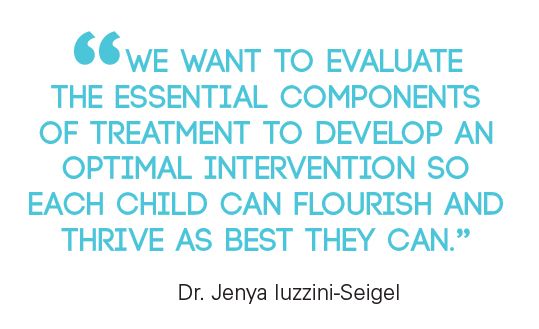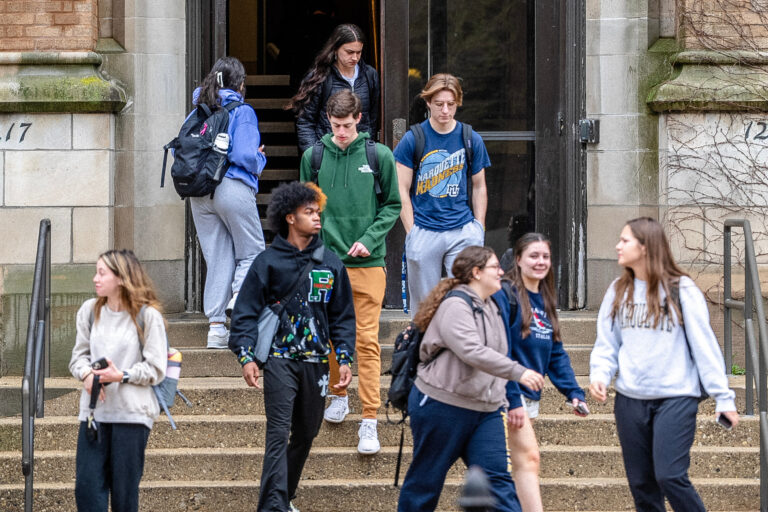With the goal of improving therapy for a rare speech disorder in children, Dr. Jenya Iuzzini-Seigel is studying how often treatment should be administered.

By Alex Nemec
Parents Adam Stout, Comm ’09, Grad ’15, and Jennifer Gaul-Stout were like other new parents as they waited and waited for their son, Alex, to begin hitting developmental milestones.
But as Alex approached a year old, he seemed to be missing every one of them.
“He was late to sit, to roll, walk, crawl, all of those things. He wasn’t saying words and wasn’t making any noise at all. He never even babbled as a baby,” says Gaul-Stout, who will graduate from Marquette in May 2022 with a Ph.D. in educational policy and leadership.
The Stouts had Alex evaluated for speech issues and learned that he had childhood apraxia of speech (CAS), a disorder affecting one to two children per thousand in which speech muscles aren’t receiving the correct brain signals. At least half of all children with CAS have language impairments and difficulty with fine and gross motor skills, just as Alex had. While a developing child may take a week to learn and begin using a speech pattern, a child with CAS may take multiple weeks or months to learn that same pattern.
Alex went to therapy for his CAS three times a week for one-hour sessions to work on building speech patterns little by little, but it wasn’t clear at the time if that was the best path. Would such frequent treatments be beneficial, or might they prove too much for the young patient and his family and slow progress if he resisted such intense therapy?

According to Dr. Jenya Iuzzini-Seigel, assistant professor of speech pathology and audiology, there is insufficient evidence to precisely guide these decisions. But she and her colleagues are working to address the research gap. With a $1.15 million grant awarded by the Once Upon a Time Foundation, Iuzzini-Seigel will lead a project to study two different frequency modes of a therapy called Dynamic Temporal and Tactile Cueing (DTTC) in 60 children with CAS who are between 30 months and seven years of age. One group of children will receive therapy twice a week for 12 weeks and another will receive therapy four times per week for six weeks — each receiving 24 total treatment sessions.
With DTTC, a therapist asks a child to repeat specific words to improve the brain’s ability to program and plan movements for speech. The therapist provides supportive cues such as asking the child to say a word simultaneously with the therapist, while watching the therapist’s mouth move. Over time, as the child becomes more independent, the therapist fades these supportive cues.
The results of this study will play a crucial role in determining what is the most effective and efficient treatment schedule for children with CAS.
“We want to find the treatment frequency that makes the most sense for everyone involved,” Iuzzini-Seigel says. “That includes the child, the parents and the clinicians. How can we administer treatment in the most effective way possible while bringing the least amount of strain on the family and the clinicians.”
Finding the frequency treatment sweet spot
The new study builds on Iuzzini-Seigel’s research from 2018, which found that children who have CAS require more frequent practice sequencing speech and sound movements than children with typical speech abilities. The sequencing involves learning intricately choreographed but ultimately unconscious movements of lips, tongue, jaw and breath.
With co-principal investigators at New York University, Hofstra University, the University of Vermont and the University of Sydney, Iuzzini-Seigel aims to see if a higher treatment frequency in a shorter amount of time will be more effective than a lower frequency in a longer period.
“Our hypothesis is that if we see children more frequently, they will have more exposures to the treatment targets each week and therefore have faster and more substantial gains,” Iuzzini-Seigel says.

She says some clinicians and schools may want to provide treatment at more intensive and frequent levels, but the hard data isn’t there to support it.
“If the usual treatment frequency the family was attending was two times a week for 30 minutes and now they are being asked to go four times a week for an hour, we want to know more frequent treatment works for the child or if it is too burdensome,” Iuzzini-Seigel says. “If we are telling clinicians to bring kids into treatment at least three times a week, the data really needs to be strong to support that more often is really better.”
The research will also focus on what the ideal treatment frequency is while taking into consideration the capacity in which families can attend therapy, how much therapy a child can handle and other logistical factors that will be investigated in surveys.
“If we find that two sessions a week is enough to get the job done, that would be informative,” Iuzzini-Seigel says. “Or, at the end, if the group outcomes are equal, we could administer a treatment based on what works better for the specific clinical situation — whether it is based on the clinician’s demands, parents’ demands or what the child can best tolerate.”
Alex, now 5 years old, has progressed.
“He went from being able to say ‘mama’ or ‘dada’ and maybe one other word to speaking in full sentences,” says Gaul-Stout.
Real world treatment solutions
Care of the whole child is the motivation behind Iuzzini-Seigel’s research, she says, and her research will help give definitive reasoning for the treatment being administered.
“We want to evaluate the essential components of treatment to develop an optimal intervention so each child can flourish and thrive as best they can,” she says. “We don’t want to waste anyone’s time, especially not the time of children and families who have so much they are coping with. If possible, we want to support families and give them free time that is not devoted to providing treatment to their child and bringing them to appointments. This research will let us know if more frequent treatment is worth the potential added resources and family burden.”
Furthermore, Iuzzini-Seigel and her team have a desire to determine the most efficient way to make this treatment work for everyone involved, including the clinicians.
“In research, we often do very detailed, multi-level, time-consuming evaluations and data analysis protocols that would be difficult for a practicing clinician to perform in the real world,” Iuzzini-Seigel says. “They wouldn’t have time to learn the protocols, administer them and process the data afterwards.”
In the coming weeks and months, Iuzzini-Seigel and her team will continue solidifying their research procedures so that they are feasible in a clinical setting and begin the process of hiring and training community clinicians across the country. This fall, her team will train their clinical team to ensure they are research-ready and prepared to provide DTTC treatment.
“This will be a really important study. Whatever we find will be informative and will be very helpful for clinicians in the world to be able to use,” Iuzzini-Seigel says.



